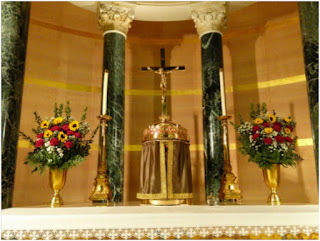Cantus Ecclesiasticus: “Ecclesiastical Chant”
Legend has it that the music of the Church’s Latin
Tradition, that came to be known as Gregorian chant, was dictated to St.
Gregory the Great by the Holy Spirit, who came to him in the form of a dove.
This portrayal of the great pope has found its way into the treasury of Western
artwork.
In this triptych, we see St. Gregory the
Great wearing the papal appointments: the papal tiara, ferula (staff) with
triple cross, white alb and shoes, with white gloves. In his left hand, he
holds a book that, if you look very closely, you can see contains music. With his right hand, he holds a plume and writes in
the book, while the dove sings into his ear.
While this piece presents a compelling tale,
it is more likely that Gregory was not the composer of the chants that bear his
name. The great contribution of Gregory to the treasury of sacred music and to
the Church’s liturgy was his organization of liturgical books. Gregory codified
the body of chant according to the liturgical year, and ordered them in the
context of the Mass and the Divine Office in his liturgical reforms.[1]
In fact, today’s liturgical books (the Roman Missal, the Roman Gradual, etc.)
owe their organizational structure to St. Gregory the Great. He organizes the
Order of Mass in the following structure: the Proper of Time, the Proper of
Saints, and the Common Masses and Prayers, into what is known as the “Gregorian
Sacramentary.”[2] We see this
too in his organization of the Divine Office.
You may be asking yourself, “If he didn’t
compose it, why is it called Gregorian chant?” Over the past couple of decades,
new albums of this old music climb to the top of the charts in the secular
world, and people from all walks of life are attracted to this ancient
tradition. Where did this music
come from?
In short, Gregorian chant develops out of a
tradition of cantillation (sung-speech) of scriptural passages in the sacred
liturgy. It is the monophonic (single-voice) music of the Roman Rite, and its
sole purpose is to amplify and elevate the words of the liturgy. Its melodies
are found in written sources dating back to the ninth century, with the oral
tradition extending back some time prior to the bibliographical record. The
link of the scriptural texts upon which the chants are built goes back even
further in time. Today, Gregorian chant remains the music proper to the Roman
Rite, and holds pride of place.[3]
Gregorian chant is often described as
“other-worldly;” it sounds as though it is not of this earth. It sounds holy,
sacred, set apart. Perhaps in this landscape of holy sound, we find the appeal
of the legend of its composition. Let us then take a step back and appreciate
the whole of the artwork once more. On either side of the great pope, the angels
play instruments, lute and violin, while he listens to the music of the Holy
Spirit. The triptych calls us to a vision of music in the Mass that participates
in the music of heaven: the sound of the heavenly liturgy.
-Written by Alexis Kutarna (Music Director for St. Mary's Seminary)
[1] Robert
Hayburn, Papal Legislation on Sacred
Music 95 A.D.-1977 A.D. (Harrison, New York: Roman Catholic Books, 1978).
[2] In this
period in history, before we have compilations of what we will later call
“plenary missals” (books containing everything needed for Mass), we have
separate liturgical books for each of the ministers. The term “sacramentary”
refers to the book containing the prayers for the priest (sacerdos). There would also be a “lectionary” containing the
lections, an “antiphonary” containing the antiphons, even an “evangeliary”
containing the Gospels. A true plenary missal would contain all of the material
for the Mass (prayers, lections, etc). The “big red book” currently is use by
the priest for Mass is not a plenary missal, nor exclusively a sacramentary.
[3] Constitution
on the Sacred Liturgy, no. 116.





Comments
Post a Comment